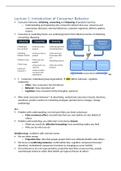Class notes
Summary of the Consumer Behavior lectures 2023
- Course
- Institution
Exam grade: 8,4 This summary contains all the discussed information of the lectures Consumer Behavior, including notes of the example exam questions and important information of the mandatory articles
[Show more]



